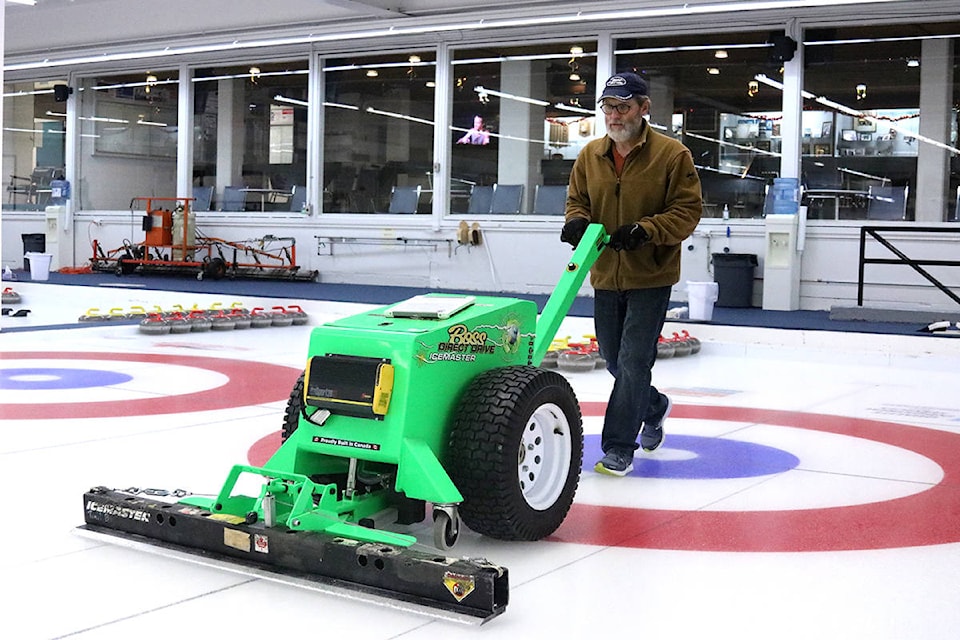Trail Curling Club’s ice maker, Mike Williams, will take his game to the national level when he joins the team of ice technicians at the Scotties Tournament of Hearts in Penticton next month.
Williams is one of about 15 ice makers assigned to build and maintain the curling sheets at the South Okanagan Events Centre during the women’s national curling championship, Jan. 27-Feb. 4.
“This will be my first national event and first arena event,” said Williams. “It’s exciting and I know the theory, because I’ve installed ice lots, did all the ice installation up in Rossland, but to actually do it for the elite level is a whole new ballgame.”
The Rossland native has ample experience, that includes seven years at the Rossland Curling Club before joining the Trail Curling Club earlier this year. Williams also maintained the ice at the B.C. Senior Curling championship in Trail in 2013 and the 2016 men’s provincial curling championship in Nelson. However, crafting 12 sheets in a hockey-arena venue for the world’s best curlers is unchartered territory for Williams.
“It’s a lot more pressure because it’s the big leagues and any of your mistakes are amplified and talked about on national T.V.”
Williams, a certified level 2 ice-maker, will be attending the women’s curling championship as part of the protocol necessary to complete his level-3 ice technician course.
“Part of the schooling that I have to do is to work two arena events, and three provincial events.”
His crew at the Scotties is in charge of the ice, the rocks, and the arena, and will arrive a week early to prepare the arena ice for the curling sheets. In addition to shaving, levelling, and flooding the ice, the crew will white wash the whole arena surface to hide the hockey lines, advertising etc., and begin crafting the curling surfaces, lines and rings, adding a foam border, then flood, scrape, level, repeat and pebble.
When complete, the glistening level surface will be mercilessly pounded by Canada’s best curlers for the next week and with temperatures fluctuating day-to-day (depending on variables like crowd size, outside temperature, shed temperature, and curler heat load), the many and varied challenges for the ice technicians will continue unabated.
“There will be 5,000 people watching it,” said Williams. “So some of the intricacies is that the room is massive, so the humidity and the temperature and the ice temperature and all that effects on how the rocks ride down the ice.
“With a room that big, and that big of a crowd in there it changes things very quickly and effects the ice fairly quickly and that’s when you start hearing on TV, comments from the commentators that there is a straight spot there or it’s really swingy, and they’re really talking about the job that the ice-maker’s done and the condition of the ice.”
The best players adapt, and so do the ice makers, as they tweak and adjust the brine, slab and ice temperatures, and the humidity to as close to ideal conditions as they can get. But those adjustments take time to take effect, and it’s a game of playing catch up, said Williams.
The ice techs also study the rocks and if obvious discrepancies appear in the way a rock curls or doesn’t curl, the technicians will make adjustments by buffing and/or sanding the stones.
“You listen to the curlers, you’re watching rocks yourself, and you watch how each rock is reacting on the ice … sometimes they just need to be touched up a little bit.”
For Williams, ice making is a compelling and complex science that requires an artist’s sensibilities combined with a little luck. The process is what fascinates him but satisfaction comes from seeing club and elite level curlers enjoy the game, whether they realize what went into it at the ice level or not.
“I like the challenge and I like trying to give our curlers the best possible ice surface to play their game on,” said Williams. “That’s what it comes down to at the club level is making the curlers happy. At the elite level, it’s really a game of consistency, you want to be as consistent as possible from the first draw right through to the last draw, and the final game you want that ice to be exactly the same so the curlers don’t have to change things up in their game.”
The potential for ice makers is similar to athletes who strive to compete in national and world championships. Williams would like to follow in his former instructor and renowned B.C. ice maker B. J. Gagnon’s footsteps. Gagnon is heading the ice-technician contingent at the 2018 Olympic Games in Pyeong Chang, South Korea.
“I’d like to work some national events, maybe a worlds. If I can sneak into an Olympic crew, I’ll push a broom on Olympic ice. Doesn’t matter to me if I’m on a straightener, a pebbler or a broom just to have that experience of being there and learning.”
For now, Williams is thrilled to have the opportunity to watch Canada’s best female curlers go head-to-head. Yet, the job comes first, and he is commited to the learning process and improving his craft so he can share the results with Greater Trail curlers.
“I’m hoping to expand my knowledge base, of course, and learn as much as I possibly can. Whether they’re little tricks of the trade or new ways of doing things, I can bring it back here so I can give our guys that same quality of ice.”
The B.C. women’s curling championship goes in Victoria Jan. 2-7, with the provincial champion competing at the Scotties Tournament of Hearts in Penticton Jan. 27 to Feb. 4.
